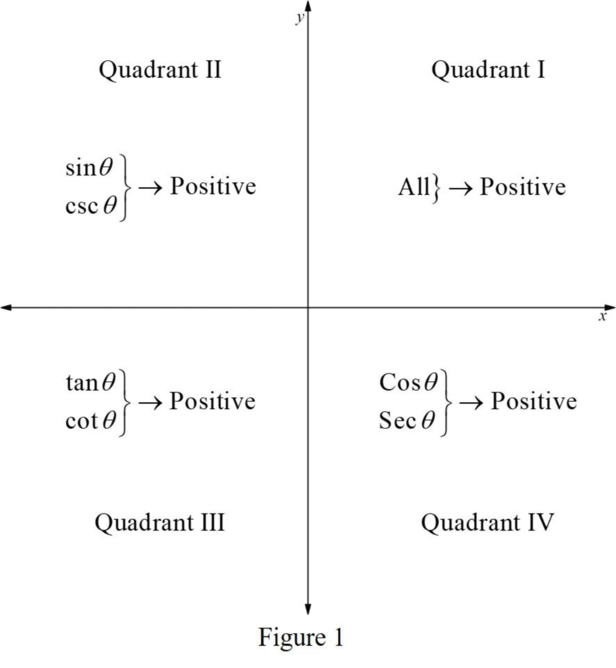
Whether the statement “If
Answer to Problem 1RE
The given statement is
Explanation of Solution
It is a known fact that all trigonometric ratios are positive in the first quadrant
The trigonometric ratios sine and its reciprocal cosecant are positive in the second quadrant
The trigonometric ratios tangent and its reciprocal cotangent are positive in the third quadrant
The trigonometric ratios cosine and its reciprocal secant are positive in the fourth quadrant
Represent the above facts more clearly as shown in below Figure 1.

From Figure 1, it can be concluded that if
Therefore, the given statement “If
Want to see more full solutions like this?
Chapter 8 Solutions
Student Solutions Manual For Basic Technical Mathematics And Basic Technical Mathematics With Calculus
- Based on the software output, write the fitted simple linear regression equation. Coefficients Term Coef SE Coef T-Value P-Value Constant 3.20 1.92 1.67 0.237 [Select] y= 0.600 0.566 1.06 0.400 +[Select] x Does a simple linear regression model seem reasonable in this situation? [Select]arrow_forward30.4. Suppose that f(2) has a pole of order m at zo. Show that f'(z) has a pole of order m + 1 at zo-arrow_forwardA drink filling machine, when in perfect adjustment, fills the bottles with 8 ounces of drink on an average. Any overfilling or underfilling results in the shutdown and readjustment of the machine. A sample of 20 bottles is selected, and the sample shows an average filling volume of 7.5 ounces. To determine whether the machine is properly adjusted, the correct set of hypotheses Ho: [Select] [Select] H₁: [Select] [Select] > [Select] [Select]arrow_forward
- Information on a packet of seeds claims that 93% of them will germinate. Of the 200 seeds that were planted, only 180 germinated. 95% confidence interval for the true proportion of seeds that germinate based on this sample is (85.8%, 94.2%). Do the data provide evidence against the claim? [Select] The margin of error in the estimate is: [Select] > To keep the margin of error within 3.5% with at least 95% confidence level, the required sample size is: [Select]arrow_forwardThis has to be done advanced mathematics report , also give the code for this. And do not give chatgptarrow_forwardBusiness discussarrow_forward
- Find the Taylor polynomial T³(×) for the function f centered at the number a. f(x) = xe-2x a = 0 T3(x) =arrow_forward538 Chapter 13 12. Given: Points E(-4, 1), F(2, 3), G(4, 9), and H(-2, 7) a. Show that EFGH is a rhombus. b. Use slopes to verify that the diagonals are perpendicular. 13. Given: Points R(-4, 5), S(-1, 9), T(7, 3) and U(4, -1) a. Show that RSTU is a rectangle. b. Use the distance formula to verify that the diagonals are congruent. 14. Given: Points N(-1, -5), O(0, 0), P(3, 2), and 2(8, 1) a. Show that NOPQ is an isosceles trapezoid. b. Show that the diagonals are congruent. Decide what special type of quadrilateral HIJK is. Then prove that your answer is correct. 15. H(0, 0) 16. H(0, 1) 17. H(7, 5) 18. H(-3, -3) I(5, 0) I(2,-3) 1(8, 3) I(-5, -6) J(7, 9) K(1, 9) J(-2, -1) K(-4, 3) J(0, -1) K(-1, 1) J(4, -5) K(6,-2) 19. Point N(3, - 4) lies on the circle x² + y² = 25. What is the slope of the (Hint: Recall Theorem 9-1.) - line that is tangent to the circle at N? 20. Point P(6, 7) lies on the circle (x + 2)² + (y − 1)² = 100. What is the slope of the line that is tangent to the circle at…arrow_forwardConsider a set of data ...arrow_forward
- For each graph in Figure 16, determine whether f (1) is larger or smaller than the slope of the secant line between x = 1 and x = 1 + h for h > 0. Explain your reasoningarrow_forwardAnalyze the residuals of a linear regression model and select the best response. yes, the residual plot does not show a curve no, the residual plot shows a curve yes, the residual plot shows a curve no, the residual plot does not show a curve I answered, "No, the residual plot shows a curve." (and this was incorrect). I am not sure why I keep getting these wrong when the answer seems obvious. Please help me understand what the yes and no references in the answer.arrow_forwardDesign a Turing Machine recognizing each of the following languages and draw its state diagram. Note that the transition functions of the Turing Machine must be in the format of “a → b,L/R", namely the machine reads single symbol a from the tape, writes single symbol b to the cell to replace a, and then goes to either left L or right R. You will receive 0 point if you do not follow this instruction. (1) {w|w=a²b³, n ≥ 0} (2) {w|w=a'b³,i0} (3) {w|w a'bick,iarrow_forwardarrow_back_iosSEE MORE QUESTIONSarrow_forward_ios
 Discrete Mathematics and Its Applications ( 8th I...MathISBN:9781259676512Author:Kenneth H RosenPublisher:McGraw-Hill Education
Discrete Mathematics and Its Applications ( 8th I...MathISBN:9781259676512Author:Kenneth H RosenPublisher:McGraw-Hill Education Mathematics for Elementary Teachers with Activiti...MathISBN:9780134392790Author:Beckmann, SybillaPublisher:PEARSON
Mathematics for Elementary Teachers with Activiti...MathISBN:9780134392790Author:Beckmann, SybillaPublisher:PEARSON
 Thinking Mathematically (7th Edition)MathISBN:9780134683713Author:Robert F. BlitzerPublisher:PEARSON
Thinking Mathematically (7th Edition)MathISBN:9780134683713Author:Robert F. BlitzerPublisher:PEARSON Discrete Mathematics With ApplicationsMathISBN:9781337694193Author:EPP, Susanna S.Publisher:Cengage Learning,
Discrete Mathematics With ApplicationsMathISBN:9781337694193Author:EPP, Susanna S.Publisher:Cengage Learning, Pathways To Math Literacy (looseleaf)MathISBN:9781259985607Author:David Sobecki Professor, Brian A. MercerPublisher:McGraw-Hill Education
Pathways To Math Literacy (looseleaf)MathISBN:9781259985607Author:David Sobecki Professor, Brian A. MercerPublisher:McGraw-Hill Education





